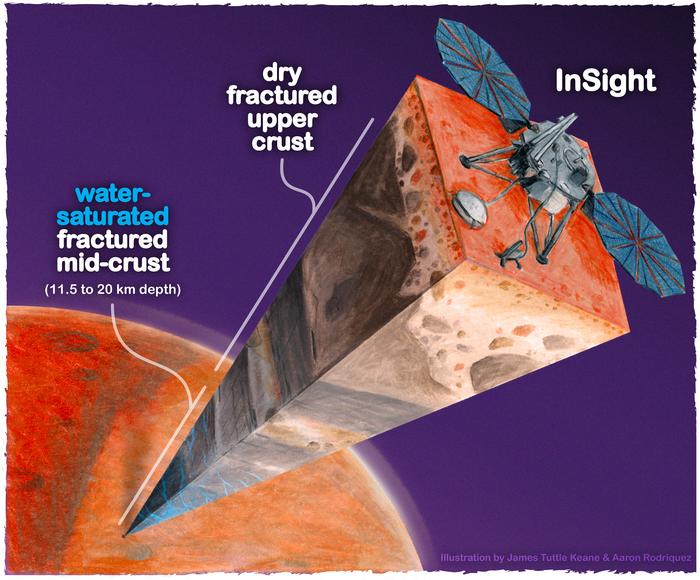Mars, the Red Planet, may hold more secrets beneath its dusty surface than ever imagined. Recent discoveries suggest that liquid water may still exist within its crust.
This groundbreaking finding, derived from seismic data collected by NASA’s InSight lander, could reshape our understanding of Mars’ potential to harbor life and its geological history.
For over three billion years, Mars has been a dry and barren world, losing its surface water as its atmosphere thinned. In the distant past, rivers, lakes, and even oceans flowed on its surface.

Over time, this water disappeared, either escaping into space, becoming trapped in ice, or seeping into underground aquifers. However, recent data reveal that liquid water might persist in the planet’s mid-crust, defying earlier assumptions.
The InSight mission, which concluded in 2022, explored the Martian subsurface using geophysical measurements. Seismic data allowed researchers to study how waves generated by Marsquakes traveled through different layers of the crust. These measurements provided a detailed glimpse into the planet’s interior composition.
Analysis by a team led by Vashan Wright, a geophysicist at UC San Diego’s Scripps Institution of Oceanography, unveiled compelling evidence of water-saturated fractures within the mid-crust, located 11 to 20 kilometers below the surface. This depth, where temperatures could allow liquid water to exist, is a layer scientists had previously hypothesized but lacked direct evidence to confirm.
The study, published in Proceedings of the National Academy of Sciences, highlights the innovative methods used to interpret the seismic data. Wright’s team applied a Bayesian inversion model combined with rock physics theories to analyze seismic velocities and bulk density within the Martian crust.
Related Stories
These advanced techniques allowed them to determine that thin fractures in igneous rock, filled with liquid water, best explained the observed data.
“Understanding the Martian water cycle is critical for understanding the evolution of the climate, surface, and interior,” Wright noted. The discovery underscores the importance of using geophysical tools to map water distribution, not only for scientific exploration but also for future Mars missions.
Temperatures near the top of the mid-crust layer, combined with high pressure, create conditions where liquid water can remain stable. Meanwhile, at greater depths, the immense pressure closes the pores, eliminating spaces where water could exist. This mid-crustal layer, detected within 50 kilometers of the InSight lander, could represent a global feature of the Martian crust.

Water is essential for life as we know it, and the discovery of liquid water on Mars—even deep underground—opens new possibilities in the search for extraterrestrial life. If microorganisms existed on ancient Mars, subsurface water could have provided a refuge as surface conditions became increasingly inhospitable.
“While available data are best explained by a water-saturated mid-crust, our results highlight the value of geophysical measurements and better constraints on the mineralogy and composition of Mars’ crust,” the study’s authors wrote. This emphasizes how precise data collection and analysis are key to understanding planetary environments.
The presence of liquid water also enriches our knowledge of Mars’ climate history. During the Noachian and Hesperian periods, over three billion years ago, Mars had a more hospitable climate capable of sustaining surface water. The remnants of that water, now hidden underground, serve as clues to the planet’s evolutionary journey.
This research lays the groundwork for future missions focused on studying Mars’ interior and potential habitability. Scientists now have a better understanding of where to look for water—a crucial resource for both scientific discovery and potential human colonization.

Geophysical techniques, like those used by Wright’s team, could be adapted for other planetary bodies, broadening our search for life and habitable conditions beyond Earth.
The study, supported by institutions including the Canadian Institute for Advanced Research and the U.S. Office of Naval Research, underscores the value of international collaboration in unraveling the mysteries of our solar system.
Collaboration between experts in planetary science, geophysics, and engineering drives these discoveries forward, inching us closer to answering fundamental questions about life beyond Earth.
The findings also highlight the importance of ongoing data analysis from past missions like InSight. Each piece of information builds upon the last, creating a more comprehensive picture of Mars’ geological history and its potential for supporting life.
As Wright and his colleagues continue their research, they pave the way for more targeted exploration of Mars and its hidden reserves of water.
If liquid water does indeed flow through the fractures of Mars’ crust, it challenges the long-held perception of the planet as an entirely dry and barren world. Instead, Mars emerges as a more dynamic and potentially life-sustaining environment, bringing humanity closer to solving the mysteries of the Red Planet.
Note: Materials provided above by The Brighter Side of News. Content may be edited for style and length.
Like these kind of feel good stories? Get The Brighter Side of News’ newsletter.
The post Scientists found compelling evidence of liquid water on Mars appeared first on The Brighter Side of News.